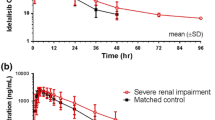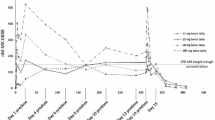Summary
Purpose SGX523 is an orally bio-available, ATP competitive, small molecule inhibitor of MET, binding the kinase domain active site in a novel mode. Two phase 1, open-label, dose-escalation studies of SGX523 were conducted to evaluate both interrupted and continuous dosing schedules. Methods Thirty-six patients per study were planned to be enrolled. The first study explored a 21-day cycle with SGX523 administered on an intermittent schedule at a starting dose of 60 mg PO BID for 14 days followed by 7 days of rest. The second protocol explored a continuous 28-day dosing schedule with SGX523 administered at a starting dose of 20 mg PO BID for 28 days without rest. Results A total of 10 patients were enrolled, 2 on the intermittent dosing protocol and 8 on the continuous dosing protocol. All 6 patients that received daily doses of ≥ 80 mg developed unexpected renal failure manifested by an early rise of serum blood urea nitrogen and creatinine. Human PK analysis revealed the formation of two insoluble metabolites at levels not seen in the rat or dog preclinical toxicology studies. Subsequent primate toxicology and toxicokinetic evaluation replicated human findings, and histological examination of the monkey kidneys revealed the formation of crystals both within the renal tubules and within giant cell macrophages. Conclusion Two-species toxicology studies of SGX523 did not predict the occurrence of renal toxicity in the human. Subsequent primate toxicology studies suggest the cause of the renal failure seen in humans was a crystal nephropathy secondary to insoluble metabolites. SGX523 is no longer in clinical development.




Similar content being viewed by others
References
Schmidt L, Junker K, Weirich G, Glenn G, Choyke P, Lubensky I et al (1998) Two North American Families with Hereditary Papillary Renal Carcinoma and Identical Novel Mutations in the MET Proto-Oncogene. Cancer Res 58(8):1719–1722
Schmidt L, Duh F-M, Chen F, Kishida T, Glenn G, Choyke P et al (1997) Germline and somatic mutations in the tyrosine kinase domain of the MET proto-oncogene in papillary renal carcinomas. Nat Genet 16(1):68–73
Rege-Cambrin G, Scaravaglio P, Carozzi F, Giordano S, Ponzetto C, Comoglio PM et al (1992) Karyotypic analysis of gastric carcinoma cell lines carrying an amplified c-met oncogene. Cancer Genetics and Cytogenetics 64(2):170–173
Okada K, Sugihara H, Bamba M, Bamba T, Hattori T (2000) Sequential numerical changes of chromosomes 7 and 18 in diffuse-type stomach cancer cell lines: combined comparative genomic hybridization, fluorescence in situ hybridization, and ploidy analyses. Cancer Genetics and Cytogenetics 118(2):99–107
Kovacs G (1993) Molecular cytogenetics of renal cell tumors. Adv Cancer Res 62:89–124
Inoue T, Kataoka H, Goto K, Nagaike K, Igami K, Naka D et al (2004) Activation of c-Met (hepatocyte growth factor receptor) in human gastric cancer tissue. Cancer Sci 95(10):803–809
Borset M, Hjorth-Hansen H, Seidel C, Sundan A, Waage A (1996) Hepatocyte growth factor and its receptor c-met in multiple myeloma. Blood 88(10):3998–4004
Koochekpour S, Jeffers M, Rulong S, Taylor G, Klineberg E, Hudson EA et al (1997) Met and hepatocyte growth factor/scatter factor expression in human gliomas. Cancer Res 57(23):5391–5398
Buchanan SG, Hendle J, Lee PS, Smith CR, Bounaud PY et al (2009) SGX523 is an exquisitely selective, ATP-competitive inhibitor of the MET receptor tyrosine kinase with antitumor activity in vivo. Molecular Cancer Therapeutics 8(12):3181–90
Declaration of Helsinki. Ethical principles for medical research involving human subjects World Medical Association 1964.
Burley S (2009) SGX523 is an exquisitely selective ATP-competitive inhibitor of MET receptor tyrosine kinase. New York Academy of Sciences Symposium
Diamond S, Boer J, Maduskuie TP, Falahatpisheh N, Li Y (2010) Yeleswaram S species-specific metabolism of SGX523 by Aldehyde Oxidase and the toxicological implications. Drug Metabolism and Disposition 38(8):1277–1285
Conflicts of Interest
Terence Rugg, Isabelle Rooney, Raymond Liu: Full time employment by sponsor.
All other investigators have no other conflict.
Study was fully sponsored by SGX Pharmaceuticals.
Author information
Authors and Affiliations
Corresponding author
Additional information
Both studies described were fully supported financially and sponsored by SGX Pharmaceuticals.
Original publication. No part of this data has been presented in any form.
Electronic supplementary material
Below is the link to the electronic supplementary material.
Esm 1
Structure of SGX523 (PDF 16 kb)
Appendix: Nonclinical study methodology
Appendix: Nonclinical study methodology
An exploratory monkey toxicology study was initiated in an attempt to recapitulate the human toxicity. Two male cynomolgus monkeys (Macaca fascicularis) of 3.6 and 4.1 years of age (3.8 and 4.4 kg on study Day −1) were imported from China via Prime Resources Development Bio-services Ltd., Kowloon, Hong Kong. Animals were purpose-bred and experimentally naïve, and housed individually in stainless-steel cages. Primary enclosures were as specified in the USDA Animal Welfare Act (9 CFR, Parts 1, 2 and 3) and as described in the Guide for the Care and Use of Laboratory Animals (ILAR publication, 1996, National Academy Press). Animals were housed at approximately 18-29°C with greater than 10 air changes per hour, with 100 % fresh air, and a 12-hour light/12-hour dark photoperiod, except when room lights were turned on during the dark cycle to accommodate blood sampling or other study procedures. Purina Certified Primate Diet No. 5048 was provided two-times daily in amounts appropriate for the size and age of the animals, and supplemented with fruit or vegetables 2 to 3 times per week. Fruit, cereal or other treats were occasionally provided. Tap water was available ad libitum to each animal via an automatic watering device.
As part of a prestudy health screen, a physical examination under ketamine sedation was conducted by a staff veterinarian including abdominal palpation and observations of the condition of integument, respiratory, and cardiovascular systems. Other assessments included screening panels of serum chemistry and hematology; examination of fecal samples for ova and parasites; tuberculosis tests; viral screening (negative for simian retrovirus). Animals determined suitable by the staff veterinarian were used on this study. Prior to study assignment, the animals underwent at least a 31-day quarantine period as mandated by the Centers for Disease Control and Prevention, Atlanta, Georgia. Study animals were acclimated to their designated housing for at least 7 days prior to the first day of dosing.
Animals were evaluated for mortality and/or morbidity (twice daily), changes in clinical signs (daily and also 2 h after each dose), body weight (Days −5 and −1, and weekly thereafter up to and including a Day 18 necropsy). Animals were also evaluated for toxicokinetic analysis and clinical pathology indices.
Blood was collected by venipuncture from the femoral vein of each animal for evaluation of routine panels of serum chemistry (Days −5, 2, 3, 5, 8, 9, 10, 12, 14, and 17).
On Day 18, after an overnight fast, animals were terminated by exsanguination while under a deep and unrecoverable anesthesia induced with intravenous ketamine followed by Beuthanasia®-D (Schering-Plough, NJ). Kidneys and liver were weighed before fixation and organ/body weight ratios were calculated using the final body weight obtained prior to necropsy. Animals were subjected to a complete gross necropsy examination which included evaluation of the carcass and musculoskeletal system; all external surfaces and orifices; cranial cavity and external surfaces of the brain; and thoracic, abdominal, and pelvic cavities with their associated organs and tissues.
Kidneys and liver were collected and preserved in neutral-buffered 10 % formalin, embedded in paraffin, sectioned, stained with hematoxylin and eosin, and examined microscopically by a veterinary pathologist. Modifiers included severity grades of minimal, mild, moderate and marked where appropriate.
Rights and permissions
About this article
Cite this article
Infante, J.R., Rugg, T., Gordon, M. et al. Unexpected renal toxicity associated with SGX523, a small molecule inhibitor of MET. Invest New Drugs 31, 363–369 (2013). https://doi.org/10.1007/s10637-012-9823-9
Received:
Accepted:
Published:
Issue Date:
DOI: https://doi.org/10.1007/s10637-012-9823-9




